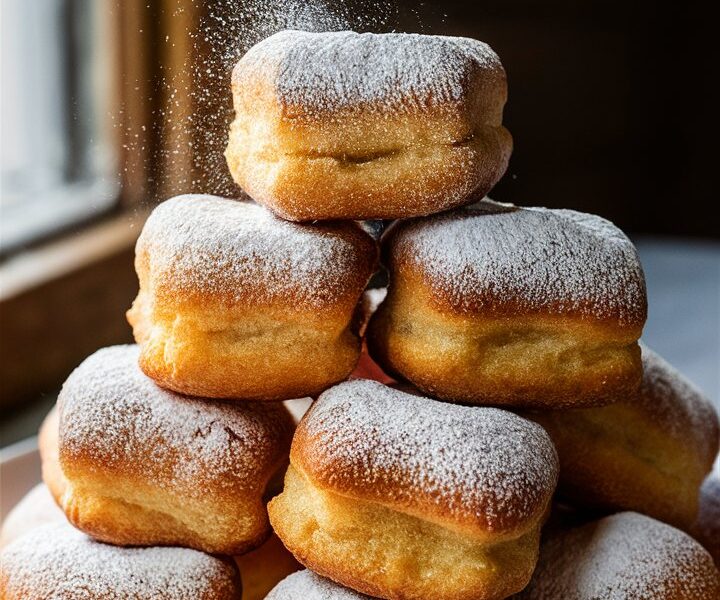Imagine stepping into a sunlit café on the cobbled streets of Paris. The air is warm with the scent of fresh coffee, the clinking of porcelain cups, and—most enchantingly—the gentle perfume of golden pastries dusted in powdered sugar. One of those pastries, the beignet, has been winning hearts for centuries.
With the Royal Bakery Box Beignet, you don’t need a plane ticket to France. You can recreate that moment in your own kitchen—complete with the light, airy texture and delicate sweetness that make beignets irresistible. This recipe is more than just a set of instructions—it’s an experience. From the first stir of yeast to the final snowy dusting of sugar, you’ll be crafting a treat that’s equal parts indulgence and tradition.
Section 1: The Story Behind the Royal Bakery Box Beignet
A Pastry with French Royalty in Its DNA
Beignets originated in France as early as the 16th century, where they were often enjoyed during festivals and special gatherings. In French, “beignet” simply means “fritter,” but these aren’t just any fritters—they were delicate, yeast-leavened pastries often served in royal courts and fine patisseries.
The Royal Bakery Box recipe takes inspiration from this rich history but simplifies the process so that even a first-time baker can succeed. It’s about bringing French elegance to the everyday table—whether that table is set for a holiday brunch or a lazy Sunday morning.
Section 2: Why This Beignet Recipe Stands Out
Not Just a Doughnut—A Work of Art
While doughnuts have a hole, beignets are fluffy pillows of dough that puff beautifully when fried. The Royal Bakery Box recipe stands apart because it focuses on:
- Cloud-like texture – Light, airy, and tender.
- Balanced sweetness – Enough to satisfy without overwhelming.
- Adaptability – Works for breakfast, dessert, or an afternoon snack.
- Beginner-friendly instructions – No advanced pastry skills required.
These beignets are also incredibly versatile—you can enjoy them plain, fill them with chocolate or fruit, or coat them in cinnamon sugar.
Section 3: The Essential Ingredients for Authentic Beignets
You might be surprised to find that you already have most of these in your pantry. The beauty of this recipe lies in simple ingredients transformed into something extraordinary.
| Ingredient | Role in Recipe | Substitution Options |
|---|---|---|
| Active dry yeast | Creates lift and puffiness | Instant yeast (skip proofing) |
| Warm water | Activates yeast | Milk or plant-based milk |
| Granulated sugar | Feeds yeast, adds sweetness | Coconut sugar, monk fruit |
| Salt | Balances flavors | Sea salt or kosher salt |
| Egg | Adds richness and structure | Flax egg (vegan option) |
| Whole milk | Enriches dough | Oat, almond, or soy milk |
| All-purpose flour | Structure and softness | Bread flour for chewier texture |
| Unsalted butter | Tender crumb, flavor | Vegan butter or margarine |
| Oil for frying | Crispy exterior | Canola, sunflower, or peanut oil |
| Powdered sugar | Classic finish | Cinnamon sugar, cocoa powder |
Section 4: Tools & Equipment for Bakery-Level Results
You don’t need a professional pastry kitchen, but having the right tools makes a huge difference.
- Mixing bowls – One large for dough, one small for yeast activation.
- Rolling pin – For even dough thickness.
- Dough scraper or sharp knife – To cut clean squares.
- Thermometer – Ensures oil stays between 350–375°F (175–190°C).
- Deep pot or fryer – For even frying.
- Slotted spoon or spider strainer – To lift beignets without crushing.
- Cooling rack – Prevents sogginess by allowing airflow.
- Sifter – For a light, even sugar dusting.
Section 5: Step-by-Step Guide to Perfect Royal Bakery Box Beignets
Step 1: Activate the Yeast
- In a small bowl, combine ¾ cup warm water (110°F/45°C) with 2 ¼ teaspoons active dry yeast and ¼ cup sugar.
- Stir gently and let sit for 5–10 minutes until foamy. If it doesn’t foam, your yeast may be inactive—start over with fresh yeast.
Step 2: Make the Dough
- In a large mixing bowl, whisk together the egg, warm milk, and softened butter.
- Add the yeast mixture and stir.
- Gradually mix in 3 ½ cups all-purpose flour and ½ teaspoon salt until a soft dough forms.
Pro Tip: If kneading by hand, use the “push, fold, turn” method for 8–10 minutes. If using a stand mixer, knead with the dough hook for 3–5 minutes.
Step 3: First Rise
- Lightly oil a clean bowl, place the dough inside, and cover with a damp cloth.
- Let rise in a warm, draft-free spot for 1–2 hours, until doubled in size.
Step 4: Shape the Beignets
- Punch down the dough to release air.
- Roll out to ¼ inch thickness on a floured surface.
- Cut into 2–3 inch squares for classic beignets.
Step 5: Fry to Golden Perfection
- Heat oil in a deep pot to 350°F (175°C).
- Fry 3–4 beignets at a time, 1–2 minutes per side.
- Remove with a slotted spoon and drain on paper towels.
Step 6: Dust and Serve
- While still warm, generously dust with powdered sugar using a sifter.
- Serve immediately for the ultimate experience.
Section 6: Variations & Flavor Twists
The Royal Bakery Box beignet is a blank canvas—here are ways to customize it:
- Chocolate-filled – Wrap squares of dark chocolate inside the dough before frying.
- Fruit-filled – Spoon raspberry jam or lemon curd into the center before sealing.
- Cinnamon sugar – Toss warm beignets in cinnamon sugar instead of powdered sugar.
- Savory twist – Fill with herbed cheese for a brunch appetizer.
- Baked beignets – Brush with butter and bake at 375°F (190°C) for 12–15 minutes.
Section 7: Serving & Presentation Like a French Pastry Chef
Presentation matters almost as much as flavor:
- Stack on a tiered cake stand for a brunch centerpiece.
- Serve with three dipping sauces—chocolate ganache, salted caramel, and berry coulis.
- Create mini beignets for parties, served in parchment cones.
- Garnish with fresh berries and mint for a summery touch.
Section 8: Storage, Reheating & Freezing Without Losing Quality
- Room temperature – Best eaten fresh but will last 24 hours in an airtight container.
- Refrigerated – Reheat in an oven or toaster oven for 5–7 minutes.
- Frozen dough – Freeze after shaping, thaw, rise again, and fry fresh.
- Avoid dusting with sugar before storage—it will dissolve and turn sticky.
Section 9: Nutrition & Health-Conscious Adjustments
Per classic fried beignet (without filling):
- Calories: ~210
- Carbs: 28g
- Fat: 10g
- Protein: 3g
- Sugar: 6g
Healthier tweaks:
- Reduce sugar in the dough by half.
- Use whole wheat pastry flour for added fiber.
- Switch to baking instead of frying.
Section 10: Troubleshooting Guide for Perfect Beignets Every Time
| Problem | Likely Cause | Fix |
|---|---|---|
| Beignets didn’t puff | Underproofed dough or oil too cool | Proof longer, maintain oil temp |
| Too greasy | Oil too cold | Fry at 350–375°F |
| Dough too dense | Overmixed or not enough yeast activity | Use fresh yeast, knead gently |
| Uneven browning | Crowded pan | Fry in small batches |
Section 11: The Royal Bakery Box Experience at Home
The magic of the Royal Bakery Box is in the ritual—mixing the dough, waiting for it to rise, watching the golden pillows float in oil, and finally dusting them with sugar. Serve them with a pot of rich coffee, a chilled mimosa, or even hot chocolate for children, and you’ve got a bakery-worthy morning without leaving home.
Conclusion – The Elegance of French Pastries in Your Kitchen
Beignets are more than just fried dough—they are a bridge between everyday life and indulgent moments. With the Royal Bakery Box Beignet recipe, you can bring a piece of Paris to your own table, no matter where you are in the world.
So, roll up your sleeves, heat up the oil, and get ready to make your kitchen smell like the streets of Montmartre. And when the powdered sugar falls like fresh snow, you’ll know—you’ve captured the essence of French pastry magic.



